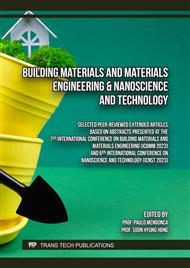p.119
p.125
p.133
p.145
p.153
p.165
p.171
p.181
p.187
Effect of Three Surface Protectors on Surface Cracking and Discoloration of Pinus Radiata Wood, after Accelerated Aging by UV Rays and Humidity
Abstract:
The objective of this study was to evaluate the effect of three types of surface protectors: Protector with and without ultraviolet pigment and hydrophobic protector, on cracking and discoloration of Pinus radiata wood, after accelerated aging caused by temperature variation, UV-A radiation and humidity. For the tests, a QUV/Spray model accelerated aging chamber was used, which simulates the spectrum of radiation emitted by the sun under controlled climatic conditions in accordance with the EN 927-6 standard. The main results show that after 11 cycles (1848 hours) of testing, the color change decreased and the presence of the number and size of cracks occurred in the order of samples with Hydrophobic protection, followed by samples with UV pigment protector. and finally, in sample with protector without UV pigment. When wood is exposed to UV radiation, it undergoes photo-oxidation, causing an alteration of the properties and the original colour. This radiation burns the surface cells (lignin) of the wood, this effect produces cracking and flaking of the wood.
Info:
Periodical:
Pages:
171-177
Citation:
Online since:
December 2023
Price:
Сopyright:
© 2023 Trans Tech Publications Ltd. All Rights Reserved
Share:
Citation:



